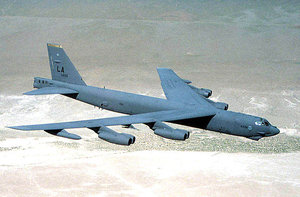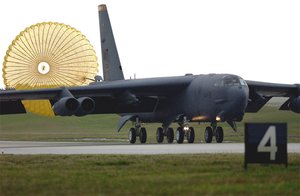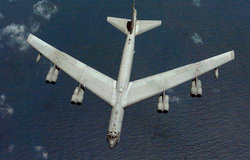B-52 Stratofortress
|
|
The Boeing B-52 Stratofortress is a long-range strategic bomber flown by the United States Air Force since 1955, replacing the Convair B-36. Although built for the role of Cold War-era nuclear deterrent, its conventional capabilities are these days the more important role in USAF operations, where its long range, heavy weapons load and fearsome reputation have proven valuable.
| Contents |
Mission
Air Combat Command's B-52 is a long-range, heavy bomber that can perform a variety of missions. The bomber is capable of flying at high subsonic speeds at altitudes up to 50,000 feet (15 km). It can carry nuclear or precision guided conventional ordnance with worldwide precision navigation capability.
Features
In a conventional conflict, the B-52 can perform strategic attack, air interdiction, offensive counter-air and maritime operations. During Operation Desert Storm, B-52s delivered 40 percent of all the weapons dropped by coalition forces.
All B-52s are equipped with an electro-optical viewing system that uses platinum silicide forward-looking infrared and high resolution low-light-level television sensors to augment targeting, battle assessment, and flight safety, thus further improving its combat ability and low-level flight capability.
Pilots wear night vision goggles (NVGs) to enhance their vision during night operations. Night vision goggles provide greater safety during night operations by increasing the pilot's ability to visually clear terrain, avoid enemy radar and see other aircraft in a covert/lights-out environment.
Starting in 1989, on-going modifications incorporates the Global Positioning System, heavy stores adapter beams for carrying 2,000 pound (900 kg) munitions, and a full array of advanced weapons currently under development.
The use of aerial refueling gives the B-52 a range limited only by crew endurance. It has an unrefueled combat range in excess of 8,800 miles (14,000 km). It is highly effective when used for ocean surveillance, and can assist the U.S. Navy in anti-ship and mine-laying operations. Two B-52s, in two hours, can monitor 140,000 square miles (364,000 km²) of ocean surface. If on land, this area is about as large as a circle centered at New York City and covered as far as Washington, DC, Syracuse and Boston (radius = 212 miles or 340 km). However, the actual shape of coverage would vary.
The aircraft's flexibility was evident in Operation Desert Storm and again during Operation Allied Force. B-52s struck wide-area troop concentrations, fixed installations and bunkers, and ruined the morale of Iraq's Republican Guard. The Persian Gulf War involved the longest strike mission in the history of aerial warfare when B-52s took off from Barksdale Air Force Base, Louisiana, launched conventional air launched cruise missiles and returned to Barksdale -- a 35-hour, non-stop combat mission. During Operation Allied Force, B-52s opened the conflict with conventional cruise missile attacks and then transitioned to delivering general purpose bombs and cluster bomb units on Serbian army positions and staging areas.
Background
For more than 40 years B-52 Stratofortresses have been the backbone of the manned strategic bomber force for the United States. The B-52 is capable of dropping or launching the widest array of weapons in the U.S. inventory. This includes gravity bombs, cluster bombs, precision guided missiles and Joint Direct Attack Munitions. Updated with modern technology the B-52 will be capable of delivering the full complement of joint developed weapons and will continue into the 21st century as an important element of the U.S.'s military capabilities. Current engineering analyses show the B-52's life span to extend beyond the year 2045.
The B-52A first flew in August, 1954, and the B model entered service in 1955. A total of 744 B-52s were built with the last, a B-52H, delivered in October 1962. Only the H model is still in the Air Force inventory and is assigned to Air Combat Command and the Air Force Reserves. The oldest B-52 still flying was a B-52B that was built in 1955, though it also has the fewest flight hours of any surviving B-52. It was operated by NASA's Dryden Flight Research Center and was used for drop tests of various research aircraft until its retirement on December 17, 2004. On July 30, 2001, Dryden received a B-52H that is expected to fully replace the older B-model aircraft by the end of 2004.The first of 102 B-52H's was delivered to Strategic Air Command in May 1961. The H model can carry up to 20 air launched cruise missiles. In addition, it can carry the conventional cruise missile that was launched in several contingencies during the 1990s, starting with Operation Desert Storm and culminating with Operation Allied Force.
The B-52 contributed to the U.S. success in Afghanistan, providing the ability to loiter high over the battlefield and provide Close Air Support (CAS) through the use of precision guided munitions. The long range and endurance of the B-52 provided a U.S. presence unmatched by any other combat aircraft. B-52's also played a key role in the third Gulf War in 2002-2003 (Operation Iraqi Freedom), where they provided close air support and bombing.
The Air Force intends to keep the B-52 in service until around 2050, an unprecedented length of service for an aircraft model. This is especially amazing considering that the last plane was built in 1962; the Air Force fully expects to be flying 90-year-old airframes.
Boeing recently suggested re-engining the B-52H fleet with the Rolls-Royce RB211 534E-4. This would involve replacing the eight Pratt & Whitney TF33s (total thrust 604.78kN) with four RB211s (total thrust 715.3kN.) This unsolicited proposal has so far met with little enthusiasm. The RR engines would increase the range/payload of the fleet and reduce fuel consumption, however the cost of the project would be significant. Procurement would cost approximately $2.56 billion ($36 million × 71 aircraft), this does not include avionics upgrades etc., though a lease arrangement has been suggested to reduce initial costs.
General characteristics
- Contractor: Boeing Military Airplane Co.
- Speed: 650 mph, 1000 km/h (Mach 0.86)
- Range: Unrefueled 8,800 miles (14,200 km)
- Armament: Approximately 70,000 lb (31,500 kg) mixed ordnance -- bombs, mines and missiles. (Modified to carry air-launched cruise missiles, AGM-84 Harpoon anti-ship and AGM-142 Have Nap missiles.)
- Accommodations: Six ejection seats
- Unit Cost: $74 million
- Date Deployed: February 1955
- Inventory: Active force, 85; ANG, 0; Reserve, 9
Production
- XB-52 - 1
- YB-52 - 1
- B-52A - 3
- B-52B - 50
- B-52C - 35
- B-52D - 170
- B-52E - 100
- B-52F - 89
- B-52G - 193
- B-52H - 102
- Total produced - 744
Trivia
- Among its crew, the B-52 is affectionately known as the "BUFF", an acronym for "big ugly fat fucker" (or "big ugly fat fellow" in more polite company).
- A hairstyle known as the "B-52", because of its resemblance to the nose cone of this aircraft, was popular in the 1950s, 60s and 70s.
- The musical band The B-52's were not directly named after this aircraft, but after the B-52 hairstyle members of the band wear.
- There is also a cocktail named for the B-52, the B-52 shooter.
- The NASA B-52B Mothership, NASA tail number 008, was retired from active service with NASA on 17 Dec 2004, after almost 50 years flying service. This was the B-52 famous for dropping such aerospace research vehicles as the X-15, X-24, HiMAT, Lifting Body vehicles, X-43, and others. It was the oldest active B-52 at the time, having first flown on June 11, 1955, and entering service with NASA in 1959. It was the last B-52B in service.
- The B-52's longevity is marked by the fact that in at least one family of airmen, the grandfather, father, and son have all served as B-52 crew.
Specifications (B-52H)
General characteristics
- Crew: 5
- Length: 159 ft 4 in (48.5 m)
- Wingspan: 185 ft 0 in (56.4 m)
- Height: 40 ft 8 in (12.4 m)
- Wing area: 4,000 ft² (370 m²)
- Empty: 195,000 lb (88,500 kg)
- Loaded: 265,000 lb (120,000 kg)
- Maximum takeoff: 488,000 lb (220,000 kg)
- Powerplant: 8× Pratt & Whitney TF33-P-3/103 turbofans; 17,000 lbf (76 kN) thrust
Performance
- Maximum speed: 650 mph (1,000 km/h)
- Combat range: 4,300 miles (6,900 km)
- Ferry range: miles ( km)
- Service ceiling: 47,000 ft (14,300 m)
- Rate of climb: ft/min ( m/min)
- Wing loading: 30 lb/ft² (150 kg/m²)
- Thrust/weight ratio: 0.51:1
Armament
- 70,000 lb (32,000 kg) of bombs
External links
- http://www.fas.org/nuke/guide/usa/bomber/b-52_hist.htm -- detailed historical overview
- http://www.af.mil/factsheets/factsheet.asp?fsID=83 -- B-52 Stratofortress Fact Sheet
- USAF B-52 mission flights from Fairford to Iraq (2003) monitored by the Frequency Monitor Centre (http://fmc.dotnet-services.nl/operation_iraqi_freedom.htm)
- NASA Dryden B-52 fact sheet (http://www.nasa.gov/centers/dryden/news/FactSheets/FS-005-DFRC.html)
| Modern USAF Series | Miscellaneous | |
| Attack--OA/A-10,AC-130H/U | RC-135V/W | |
| B-1B Lancer | Bomber--B-52,-2,-1B,F-117A | OC-135B |
| B-2 Spirit | Fighter--F-15/E ,F-16 | KC-10,-135 |
| B-52 Stratofortress | Electronic--E-3,-4B,-8C EC-130E/J,H | HC-130P/N |
| F-117A Nighthawk | Transport--C-5,-17,-141B, -20,-21 | MC-130E/H/P |
| C-22B, -32, -130, -37A, -40B/C | MH-53J/M | |
| Trainers--T-1, -37, -38, -43, -6 | HH-60G | |
| Weather--WC-130, -135 | UH-1N | |
| UAV--RQ-1/MQ-1 UAV, Global Hawk | U-2S/TU-2S | |
| VC-25 |
|
Current USAF aircraft - Bombers | |
|---|---|
|
B-1B Lancer - B-2 Spirit - B-52 Stratofortress - F-117A Nighthawk | |
Related content
Related development: B-47 Stratojet
Comparable aircraft: Tupolev Tu-95
Designation sequence: YB-49 - B-50 - XB-51 - B-52 - XB-53 - B-54 - XB-55
Related lists: List of military aircraft of the United States - List of bomber aircraft
|
Lists of Aircraft | Aircraft manufacturers | Aircraft engines | Aircraft engine manufacturers Airports | Airlines | Air forces | Aircraft weapons | Missiles | Timeline of aviation |
es:B-52 Stratofortress fr:Boeing B-52 Stratofortress nl:B-52 Stratofortress hu:B-52 ja:B-52 (爆撃機) pl:B-52 Stratofortress sv:Boeing B-52 Stratofortress



